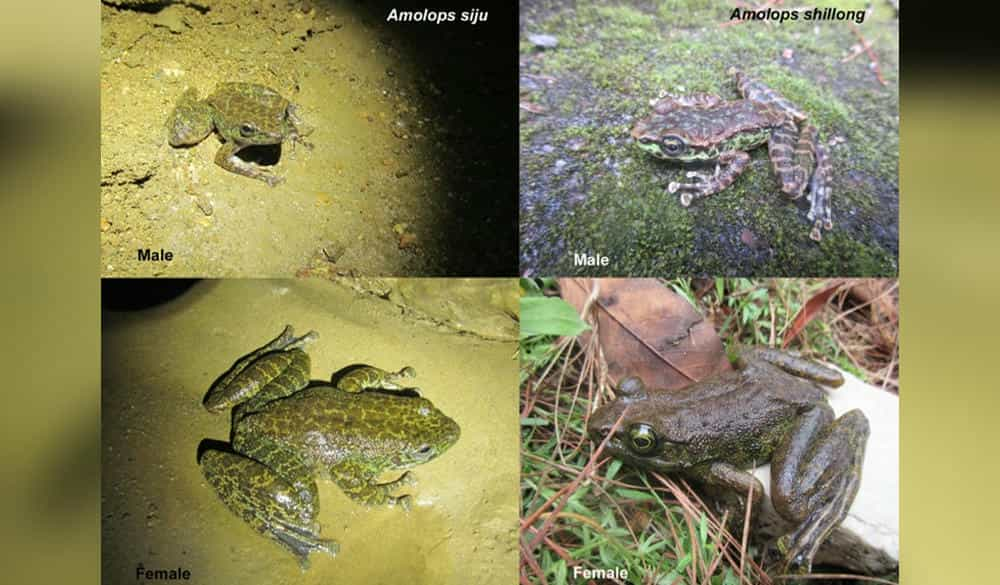From urban forest to scientific record: Meet Shillong’s new frog

A remarkable discovery has emerged from the heart of Shillong, Meghalaya’s capital—one that turns the spotlight on the biodiversity quietly thriving within city limits. Scientists from the Zoological Survey of India (ZSI), working alongside local researchers, have identified a new species of cascade-dwelling frog from Shillong’s urban forest patches. Officially named Amolops shillong, or the Shillong Cascade Frog, the species has now leapt from obscurity into the scientific record, challenging assumptions about where wildlife can survive—and thrive.
The study is detailed in the latest issue of Records of the Zoological Survey of India.
“The discovery of Amolops shillong from within Shillong’s urban landscape underscores the urgent need to integrate biodiversity conservation into city planning,” said Dr. Dhriti Banerjee, Director of ZSI. “It is a striking reminder that cities are not ecological voids but can be living repositories of unique and sensitive species. Protecting microhabitats in urban forests, streams and green corridors is essential not just for amphibians like Amolops shillong, but for the overall health of our ecosystems.”
Due to their cryptic nature—visually similar but genetically distinct—Amolops frogs often require molecular analysis for accurate identification. Using advanced genetic tools, researchers confirmed that Amolops shillong belongs to the Amolops indoburmanensis species complex. Phylogenetic analysis revealed its closest relative to be Amolops siju, a species described by the same ZSI team in 2023 from Siju Cave in South Garo Hills, Meghalaya, with a genetic divergence of 2.0% to 3.4%.
Unlike the cave-dwelling Amolops siju, Amolops shillong was found in the bustling Mawlai area of Shillong. It exhibits distinctive morphological features—including differences in size, skin texture and body proportions—which were meticulously documented through detailed morphometric and molecular analysis.
Between 2022 and 2023, three specimens of this new species were collected from urban forest patches. Two individuals were collected from the Umthlong locality of Mawlai by Damepaia Pdah, a researcher at Assam University, Silchar. A third was collected by Eugene Lyngkhoi, a Ph.D. scholar at North-Eastern Hill University (NEHU), Shillong, from the Umrynjah locality.
“We were quite surprised to find an unnamed cryptic species thriving in Shillong’s urban sprawl,” said Bhaskar Saikia, lead author of the study. “It’s a powerful reminder of how much biodiversity still remains undocumented—even in our own cities.” Interestingly Amolops species were being discovered in India since 1850’s and city species went unnoticed, says the author.
India currently has 20 recognised species of Amolops frogs, 16 of which have been described from within the country. Remarkably, nine of these—including Amolops siju in 2023 and now Amolops shillong in 2025—have been discovered in the past two decades, emphasizing North-East India’s status as a hotspot of amphibian diversity. These discoveries are part of an ongoing initiative to systematically document the region’s rich and often overlooked amphibian fauna.
Conservation Significance
The discovery of Amolops shillong is a timely reminder of the biodiversity that persists—often silently—in urban areas. Cascade frogs like these are typically indicators of clean, undisturbed freshwater ecosystems. Their presence in Shillong’s fragmented urban forest patches suggests the existence of vital microhabitats that merit immediate conservation attention.
“This discovery challenges us to rethink the value of urban ecosystems,” said Dr. Bikramjit Sinha, co-author of the study. “Urban biodiversity is often sidelined in conservation planning, but Amolops shillong proves that cities can still harbour endemic and ecologically significant species.” He added, “This is not just a scientific achievement—it’s an ecological wake-up call. We hope it inspires greater public awareness and protective action for Shillong’s streams, forest patches and green spaces.”
“Though morphologically similar, these frogs conceal abundant hidden diversity revealed through molecular tools,” said Dr. K.P. Dinesh, another co-author. “Our phylogenetic analyses suggest that many more undescribed species of Amolops await discovery in India.”
“Discovery of new species like this from the heart of a city also highlights the urgency of documenting the urban biodiversity of Shillong in particular and all other cities in general on a priority basis before these extremely vulnerable species disappear due to the acute pressure of rapid urbanisation,” said Dr. Sinha in a clarion call for immediate action.
This study was a collaborative effort, with contributions from A. Shabman of ZSI, Pune, Eugene Lyngkhoi of NEHU, Shillong and Damepaia Pdah of Assam University, Silchar, whose field and lab works were instrumental in bringing Amolops shillong to light.




Leave a Reply